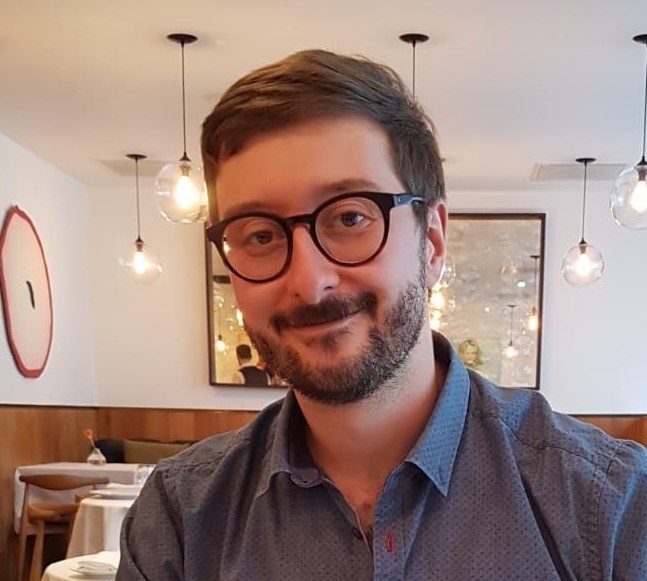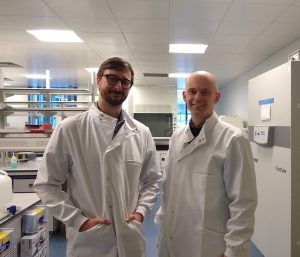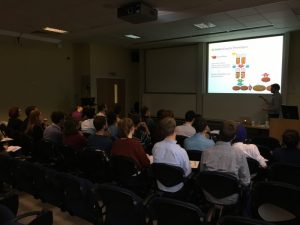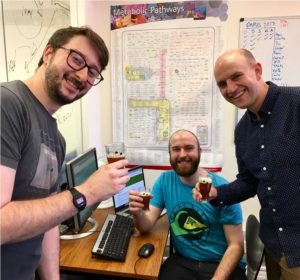
May 6, 2020, by Jo Gregory
Synthetic genomics and sustainability: An interview with Dr Ben Blount
Ben Blount recently returned to the University as a Nottingham Research Fellow in the School of Life Sciences and is a member of the Green Chemicals Beacon.
In this interview, Ben talks to Jo Gregory about his research, his inspirations, working from home during COVID and his plans for the future as part of the Beacon.
What is your role here at Nottingham?
I’m here as a Nottingham Research Fellow aligned to the Green Chemicals Beacon. This is a great position that gives me 3 years to start up my independent research, whilst making the most of the expertise around me to develop my ideas and hopefully foster some valuable collaborations.
Could you tell me a bit about your research career?
My PhD was here at Nottingham, in Prof Nigel Minton’s group. I worked on an industrially funded project with Clostridium botulinum, the organism that produces the neurotoxin used in Botox.
Following my PhD, I moved to the Centre for Synthetic Biology and Innovation, which was just starting up at Imperial College London, working for the newly appointed Tom Ellis. Together, we set up the lab and I started retraining as a synthetic biologist. I had several projects during this time, including work on promoter engineering, programmable DNA binding proteins and engineering penicillin production into yeast.
The really formative part of this time though was my involvement in the International Synthetic Yeast Genome Project, Sc2.0. As part of this project, I headed the team that built synthetic chromosome XI of the genome. The synthetic genome has some really nice features designed into it, including recombination sites associated with most genes. This allows you to “shuffle” the genome. I showed that you could use this system to make the synthetic yeast strains better at growing on new carbon sources and making high-value products.
I’m really interested in using synthetic genomics for these applications, so that’s what led me here!
How would you explain your research to an ordinary person?
Microbes are vital to a lot of industries. We use them to make medicines, chemicals, fuels, food and drinks. Every microbe has a set of genes, DNA instructions for how to behave, that make up its genome. If we want to make a microbe better at doing something, we can change these genetic instructions. As we’re getting better at doing this, we’re reaching the point where we can design and build whole genomes. This allows us to add new functions into microbes that don’t exist in nature, like the ability to quickly evolve to be better at a task, the ability to perform new types of chemistry and the inability to survive outside of a lab or fermentation tank. By advancing our abilities to build and use these “synthetic genomes”, my research aims to produce microbes for more efficient and sustainable industry and to refine our understanding of the underlying rules for how genomes function.

Ben visiting his new lab space for the first time with Dr John Heap
Why Green Chemicals? What would you like to accomplish while you’re here? How does being part of Green Chemicals help you achieve your goals?
I think that, along with medical applications, one of the most promising ways in which synthetic biology will improve our lives is by allowing us to make new and existing products with a dramatically reduced environmental impact. Synthetic genomics is a powerful, but very new approach towards getting towards this point. My aim is to to make the leap from proof of concept studies to real-world applications. To do this, the expertise and facilities at the Green Chemicals Beacon will be crucial in helping me identify the right problems to tackle and ensure that the microbial strains are developed in a way that is suitable for industrial use.
How does your research affect ordinary people?
Recent advances in synthetic genomics have given us some really powerful tools that are ripe for applying to various important problems. My hope is that this line of research will lead to biotechnology that makes the chemicals we need from sustainable or even waste materials. I also hope we will be able to engineer flexibility into these processes so that we’re not over-reliant on a particular feedstock. The environmental impact of chemical production would be mitigated by reducing our reliance on petrochemicals or specific crops, such as sugarcane, that can impact biodiversity and displace food production. An additional potential application is in the discovery of new antimicrobial compounds, which could help fight the rising problem of antibiotic resistance.
What current projects are you working on?
I’m currently working on advancing my previous work on shuffling the yeast genome from a basic, proof of concept, technique to a more powerful method that can be used to generate strains with properties beneficial to biotechnology. I’m also working on building a new accessory chromosome for yeast that will allow us to explore even more possibilities for strain improvement. This will also help us to determine the minimal number of genes needed for a cell to perform a task efficiently, hopefully leading to more efficient bioproduction.

Leading a seminar at the Synthetic Genome Summer Course
How are you finding working from home rather than the lab during a pandemic?
It was initially tough but I seem to be getting a bit more used to it now. The main two challenges are juggling work and childcare – this has really highlighted how important nurseries are – and separating work and home. This can be very difficult when you never leave the house. Luckily, having a toddler running around is a very effective way of snapping you out of “work mode”.
How did you become interested in science? Where do you get your inspirations from?
For as long as I can remember, science was my favourite subject at school and I always wanted to work in a scientific job. I’ve always wanted to know how everything worked and relished solving problems and puzzles. I never really planned to be in academic science though.
As an undergraduate student, I found that I really enjoyed the microbiology courses that I took and that made me want to work with microbes for my lab project. I enjoyed the project immensely, it was my favourite part of the whole degree and made me realise that this is actually what I wanted to do.
Do you have any advice for young scientists?
Side projects are great, always have one on the go. The main project that you’re working on is important and you should dedicate an appropriate amount of time and effort to it, but you should always make time for trying out other new ideas. Most of them will fail, but some won’t, and these are often the most exciting and rewarding pieces of work you’ll do.

Celebrating with Tom Ellis and Rob McKiernan having finished building a synthetic chromosome
What is your greatest career moment so far?
Finishing the construction of a yeast synthetic chromosome came with a massive sense of achievement. The last step was an ambitious technique to combine two halves of the chromosome together in one cell, and I wasn’t sure whether it would work or not. There was plenty of subsequent “debugging” of the sequence, but to know that the native chromosome had been completely replaced by a synthetic version that we’d built was a great feeling.
To find out more about the Green Chemicals Beacon and how our team of researchers are working to secure the low-carbon economy of the future, please visit the website or follow us on Twitter @UoN_GCB
No comments yet, fill out a comment to be the first

Leave a Reply